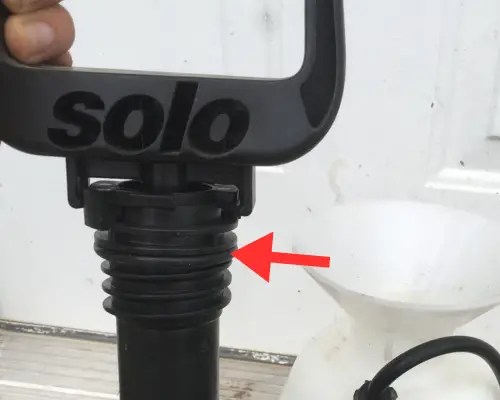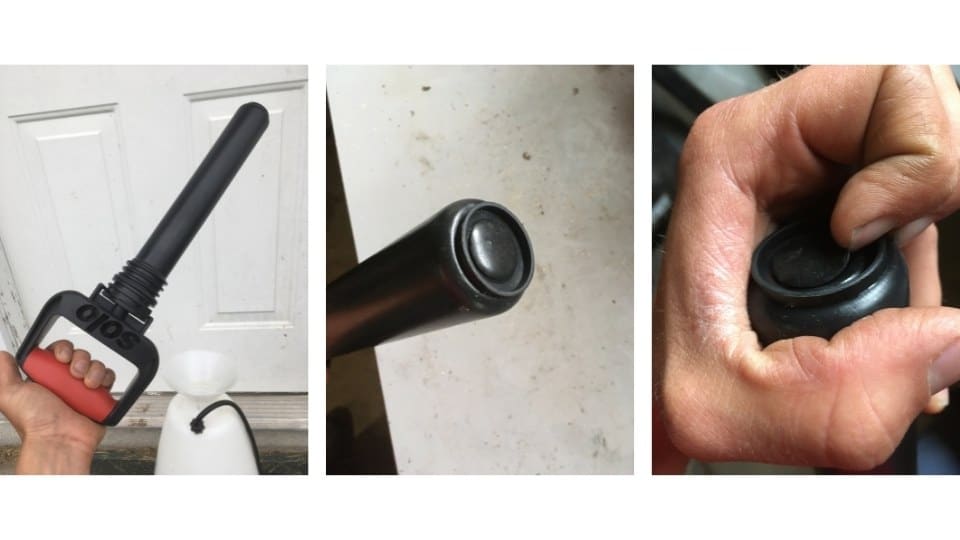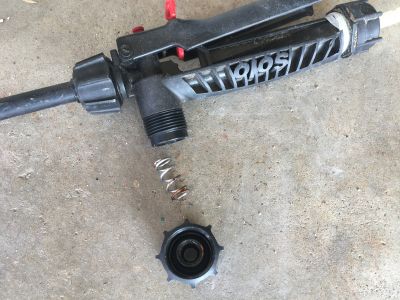If your garden sprayer is not holding pressure, it can be frustrating and completely render your sprayer useless. The most common cause of this is an air leak of some kind. The good news is that finding the leak is not too hard, the bad news is that fixing the leak can be tricky and may require new parts. Here’s a detailed guide to diagnosing and fixing pressure problems in your garden sprayer.
Why Garden Sprayers Don’t Hold Pressure
Here are the common reasons why garden sprayers don’t hold pressure. This guide will help you identify and fix the root cause of your issue.
Reason #1: Leaky Lid Gasket
Symptoms:
- After pumping the sprayer, the pressure seems to build initially but quickly fades without being used.
- You may hear faint hissing around the lid area, indicating escaping air.
- The sprayer may leak from the lid when tilted or moved.
Cause: The lid gasket (or O-ring) ensures an airtight seal between the sprayer tank and the lid. Over time, exposure to chemicals, UV light, and general wear can cause the gasket to harden, crack, or lose flexibility. If the gasket isn’t forming a tight seal, air will escape, preventing the sprayer from holding pressure.

Solution:
- Inspect the Gasket: Remove the lid and closely examine the gasket for signs of wear, cracks, or flattening.
- Lubrication: Applying a light coat of petroleum jelly can help rehydrate the gasket, improving the seal by making the rubber more pliable.
- Replacement: If the gasket is damaged or dry-rotted, replace it with a new one. If you can’t find an exact replacement, temporary fixes like using pipe thread sealer, Teflon tape, or epoxy can seal the lid, but may make future maintenance harder.
Cracks in the Tank
Symptoms:
- Air pressure diminishes quickly after pumping, even if the lid and other components seem fine.
- Visible hairline fractures in the tank may not always be obvious unless closely inspected.
Cause: Garden sprayer tanks are often made from plastic or similar materials, which can develop cracks over time due to impacts, UV exposure, or repeated exposure to corrosive chemicals. A crack in the tank will compromise its ability to maintain pressure because air leaks out of the cracks.
Solution:
- Submersion Test: Submerge the empty tank (with the lid sealed) into a bucket of water, then pump up the pressure. Look for air bubbles escaping, which will pinpoint the location of the crack.
- Temporary Fix: Small cracks can be temporarily patched using epoxy, pipe dope, or other sealants. However, these are usually short-term solutions, as sprayer tanks experience pressure that can cause the patch to fail over time.
- Permanent Solution: For larger cracks, it’s often more cost-effective to replace the entire sprayer tank or the sprayer itself.
Check Valves
Symptoms:
- The sprayer will not hold pressure, but there are no visible leaks in the tank, hose, or wand.
- Pressure may build up briefly, but as soon as pumping stops, the pressure rapidly declines.
- Air may escape audibly from the valve areas.
Cause: Check valves are critical to maintaining pressure within the sprayer. The check valve ensures that air is drawn into the pump without escaping. If these valves or their seals degrade, air can leak out, resulting in a loss of pressure.

Solution:
- Inspect the Valves: Remove and inspect the check valves and air relief valves for cracks, debris, or seal damage. Ensure that no obstructions or dried chemical residues are affecting their operation.
- Replacement: Many sprayers, such as Solo sprayers, offer replacement valve kits. If available, replace faulty valves with new ones. If parts aren’t available, you can attempt sealing the valve using pipe sealer or another suitable sealing material, though this might not be a permanent solution.
You can see more details in this blog post about hand pump sprayer troubleshooting.
Damaged Spray Wand or Hose
Symptoms:
- Air or liquid visibly escapes from the hose or wand connection points.
- Sprayer leaks when the trigger is not engaged, suggesting an issue with the connection seals.
Cause: Over time, the hose or spray wand may develop cracks, kinks, or punctures, especially if stored improperly or exposed to harsh chemicals. Additionally, poor connections where the hose attaches to the tank or wand can lead to air leaks.

Solution:
- Inspect for Visible Damage: Closely examine the entire length of the hose and spray wand for splits, cracks, or signs of wear.
- Check Connection Points: Ensure that the hose is tightly and securely connected to the tank. A loose or improperly threaded connection can leak air, leading to pressure loss.
- Replace Parts: If the hose or wand is damaged, replacing them is often the best solution. Sealing minor hose cracks with tape or sealant is a temporary fix but not recommended for long-term use.
Issues with the Pump Assembly
Symptoms:
- The pump handle feels easier to push down than normal, as if it’s not creating enough resistance.
- Air may escape from the pump area, even when the lid and tank are secure.
Cause: The pump assembly relies on an airtight seal between the rubber plunger (or piston) and the walls of the pump cylinder. If the plunger becomes dry or cracked, or if the rubber boot wears out, the pump won’t be able to generate enough pressure.
Solution:
- Lubricate the Plunger: Remove the pump assembly and lubricate the rubber plunger or piston with petroleum jelly or a silicone-based lubricant. This will help restore its flexibility and ensure a tight seal within the pump cylinder.
- Inspect for Damage: If the plunger or other components of the pump are cracked, worn, or damaged, they may need to be replaced. Some sprayers offer replacement pump kits, but if parts aren’t available, it may be more practical to replace the sprayer.
Trigger Gun Malfunction
Symptoms:
- Pressure builds up in the tank but immediately drops when the trigger gun is used, even without significant spraying.
- Air or liquid leaks from the trigger area when not in use.
- The sprayer may continue to release product even after you’ve released the trigger.
Cause: While less common than other issues, the trigger gun (which controls the flow of liquid from the sprayer) can malfunction if its internal seals or components wear out. If the trigger doesn’t seal properly when released, it can allow air to escape, reducing pressure in the tank.

Solution:
- Inspect the Trigger Gun: Check for cracks or signs of wear around the trigger mechanism and handle. If the trigger doesn’t spring back properly or air escapes, the internal valve may be damaged.
- Replacement: If the trigger gun is faulty, the best option is to replace it with a new one. Most trigger guns are not easily repairable due to their intricate internal components.
Troubleshooting Tips
- Visual Inspection: Regularly inspect your sprayer for visible signs of wear and tear, especially around seals, gaskets, and connections.
- Lubrication: Keep seals and gaskets lubricated to maintain their elasticity and effectiveness.
- Submersion Test: Use a submersion test to identify leaks by looking for bubbles when the sprayer is pumped up in water.
- Replacement Parts: Keep an eye out for available replacement parts specific to your sprayer model for easy fixes.
Other Sprayer Troubleshooting Resources
- Pump Sprayer Won’t Build Pressure
- Backpack Sprayer Troubleshooting
- Stop Sprayer from Leaking
- What to do When Sprayer Won’t Stop Spraying
Conclusion
By systematically checking these common problem areas and applying the suggested solutions, you can often restore your garden sprayer’s pressure and ensure it works efficiently for your gardening needs. If all else fails, it might be time to invest in a new sprayer.
